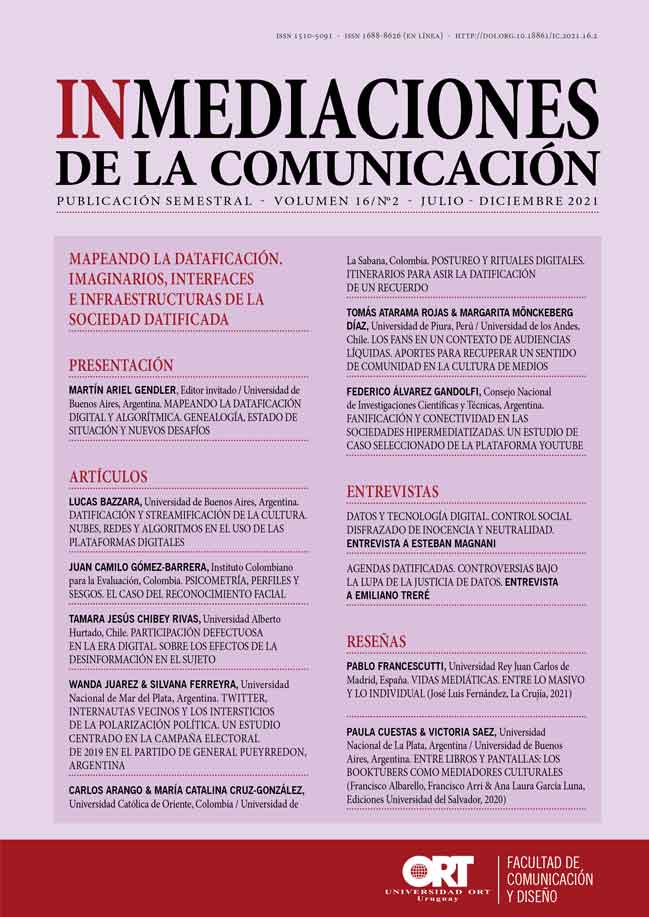Psicometría, perfiles y sesgos
El caso del reconocimiento facial
DOI:
https://doi.org/10.18861/ic.2021.16.2.3156Palabras clave:
psicometría, perfil-dividuo, reconocimiento facial, sesgosResumen
Los estudios psicométricos permiten realizar mediciones basadas en correlaciones de vectores que producen predicciones de rasgos del comportamiento humano. Con la creciente digitalización, la psicometría ha sido usada para diseñar perfiles de los individuos a través de diversos mecanismos: big data, machine learning, etc. Lejos de ser neutrales, estos perfiles están basados en metodologías que producen sesgos que afectan a los individuos perfilados. Así, este artículo plantea que la psicometría elabora un perfil-dividuo que genera una reducción de los individuos y produce formas en las que estos tienen que comportarse. Para ello, se ejemplifica con un caso de medición psicométrica basada en el reconocimiento facial.
Descargas
Citas
Ballew, C. & Todorov, A. (2007). Predicting political elections from rapid and unreflective face judgments. Proceedings of the National Academy of Sciences, 104, 17948-17953.
Benjamin, R. (2019). Race after technology: Abolitionist tools for the new jim code. Oxford: Social Forces.
Berns, T. & Rouvroy, A. (2016). Gubernamentalidad algorítmica y perspectivas de emancipación. ¿La disparidad como condición de individuación a través de la relación? Adenda Filosófica, (1), 88-116.
Bishop, C. (2006). Pattern Recognition and Machine Learning. Berlin: Springer.
Brand, S. (1994). How buildings learn: What happens after they´re built. New York: Viking-Penguin.
Cao, Q., Shen, L., Xie, W., Parkhi, O. M. & Zisserman, A. (2018). Vggface2: A dataset for recognising faces across pose and age. In AA.VV., IEEE International Conference on Automatic Face & Gesture Recognition (pp. 67-74). DOI Bookmark: 10.1109/FG.2018.00020
Carpinella, M. & Johnson, K. (2013). Appearance-based politics: Sex-typed facial cues communicate political party affiliation. Journal of Experimental Social Psychology. 49(1), 156-160. Recuperado de: https://doi.org/10.1016/j.jesp.2012.08.009
Deleuze, G. (1999). Posdata sobre las sociedades de control. En Ferrer, C. (Ed.), El lenguaje libertario. Antología del pensamiento anarquista contemporáneo (pp. 101-109). Buenos Aires: Altamira.
Geisinger, K. (Ed.) (2013). APA Handbook of Testing and Assessment in Psychology. Vol 1. Test Theory and Assessment in Industrial and Organizational Psychology. Washington, DC: American Psychological Association.
Gelman, A. (2013). Bayesian Data Analysis. London: CRC.
Gómez-Barrera, J. (2020). Las huellas digitales del comportamiento humano: gustos, neoliberalismo y algoritmos. MEDIAÇÕES, 25(3). DOI: 10.5433/2176-6665.2020.3v25n3p712
Hill, K. (June 24, 2020). Wrongfully Accused by an Algorithm. The New York Times. Recuperado de: https://www.nytimes.com/2020/06/24/technology/facial-recognition-arrest.html
Holden, D. (2000). Psycometrics. In Kazdin, A. (Ed.), Encyclopedia of psychology (pp. 417-419). New York: Oxford University Press.
Jones, L. & Thissen, D. (2007). A History of Overview of Psychometrics. In Rao, C. & Sinharay, S. (Ed.), Handbook of Statistics 26. Psychometrics (pp. 1-27). Amsterdam: Elsevier.
Kosinski, M., Stillwell, D. J. & Graepel, T. (2013). Private traits and attributes are predictable from digital records of human behavior. Proceedings of the National Academy of Sciences,110, 5802-5805.
Kosinski, M. (2021). Facial recognition technology can expose political orientation from naturalistic facial images. Nature Research, 11. DOI: https://doi.org/10.1038/s41598-020-79310-1
Lipton, Z. C. (2016). The Mythos of Model Interpretability: In machine learning, the concept of interpretability is both important and slippery. Queue, 16(3), 31-57.
Markman, A. (1998). Knowledge representation. Mahwah: Erlbaum.
Martínez, A., Hernández, M. & Hernández, L. (2006). Psicometría. Madrid: Alianza.
Messick, S. (1989). Validity. In Linn, R. (Ed.), Educational measurement (pp. 13-103). New York: American Council on Education/Macmillan.
Mislevy, R.J. & Gitomer, D. H. (1996). The role of probability-based inference in an intelligent tutoring system. User-Modeling and User-Adapted Interaction, 5, 253-282.
Redacción MIT Technology Review (1 de marzo de 2021). Ocho predicciones sobre el impacto de la tecnología en nuestra vida en 2021. MIT Technology Review. Recuperado de: https://www.technologyreview.es/s/13212/ocho-predicciones-sobre-el-impacto-de-la-tecnologia-en-nuestra-vida-en-2021
Muñiz, J. (2003). Teoría clásica de los tests. Madrid: Pirámide.
Pasquinelli, M. & Joler, V. (May 1, 2020). The Nooscope Manifested: Artificial Intelligence as Instrument of Knowledge Extractivism. KIM HfG Karlsruhe and Share Lab. Recuperado de: https://nooscope.ai
Pearl, J. (1988). Probabilistic Reasoning in Intelligent Systems. San Francisco: Morgan Kaufmann.
Roberts, T. & Bruce, V. (1988). Feature saliency in judging the sex and familiarity of faces. Perception, 17, 475-581.
Rodríguez, P. (2019). Las palabras en las cosas: saber, poder y subjetivación entre algoritmos y biomoléculas. Buenos Aires: Cactus.
Rule, N. & Ambady, N. (2008). The face of success: Inferences from Chief Executive Officers’ appearance predict company profits. Psychol Sci, 19, 109-111.
Rule, N. & Ambady, N. (2010). Democrats and Republicans can be differentiated from their faces. PLoS ONE (5). DOI: https://doi.org/10.1371/journal.pone.0008733
Rule, N., Ambady, N., Adams, R. & Macrae, C. (2008). Accuracy and awareness in the perception and categorization of male sexual orientation. Journal of Personality and Social Psychology, 95, 1019-1028.
Rust, J. & Golombok, S. (2009). Modern Psychometrics. The Science of Psychological Assessment. London: Routledge.
Rust, J., Kosinski, M. & Stillwell, D. (2021). Modern Psychometrics: The Science of Psychological Assessment. London: Routledge.
Sampson, E. E. (1981). Cognitive psychology as ideology. American Psychologist, 36, 730-743.
Segalin, C., Celli, F., Polonio, L., Kosinski, M., Stillwell, D., Sebe, D., Cristani, M. & Lepri, B. (2017). What your Facebook Profile Picture Reveals about your Personality. Proceedings of the 25th ACM international conference on Multimedia, 460-468. DOI: https://doi.org/10.1145/3123266.3123331
Sibley, C. G., Osborne, D. & Duckitt, J. (2012). Personality and political orientation: Meta-analysis and test of a Threat-Constraint Model. Journal of Research in Personality, 46(6), 664-677.
Stevens, S. (1946). On the theory of scales of measurement. Science, 106, 667-680.
Suárez, M. (2004). An inferential conception of scientific representation. Philosophy of Science, 71, 767-779.
Swoyer, C. (1991). Structural representation and surrogative reasoning. Synthese, 87, 449-508.
Wang, Y. & Kosinski, M. (2018). Deep Neuoral networks are more accurate than humans at detecting sexual orientation from facial images. Journal of Research in Personality, 114(2). DOI: 10.1037/pspa0000098
Zebrowitz, L. (1997). Reading faces: Window to the soul? Boulder: Westview Press.






